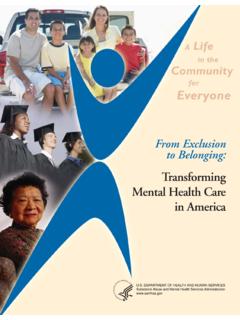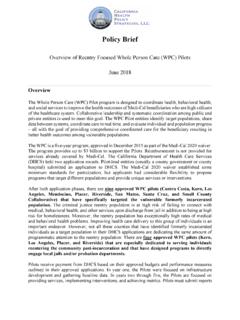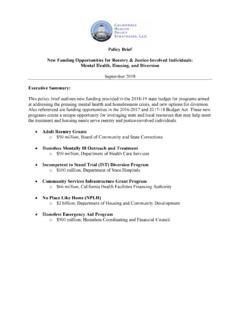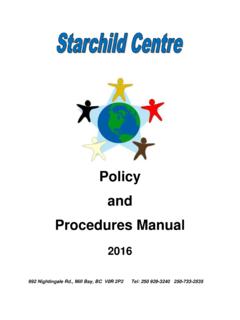Transcription of When Prisoners Return to the Community: Political ...
1 November 2000 Papers From the Executive Sessions on Sentencing and CorrectionsNo. 9 Directors MessageIt is by now a commonplace that the number of people under criminal justice supervision in this country has reached a record high. As a result, the sentencing policies driving thatnumber, and the field of corrections, where the consequences are felt, have acquired anunprecedented salience. It is a salience definedmore by issues of magnitude, complexity, andexpense than by any consensus about futuredirections. Are sentencing policies, as implemented throughcorrectional programs and practices, achievingtheir intended purposes? As expressed in themovement to eliminate indeterminate senten-cing and limit judicial discretion, on the onehand, and to radically restructure our retribu-tive system of justice, on the other, the purpos-es seem contradictory, rooted in conflictingvalues.
2 The lack of consensus on where sen-tencing and corrections should be headed isthus no surprise. Because sentencing and corrections policieshave such major consequences for the allocation of government resources and, morefundamentally and profoundly, for the quality of justice in this country and the safety of its citizens the National Institute of Justice and theCorrections Program Office (CPO) of the Officeof Justice Programs felt it opportune to explorethem in depth. Through a series of ExecutiveSessions on Sentencing and Corrections, Department of JusticeOffice of Justice ProgramsNational Institute of JusticeResearch in BriefWhen Prisoners Return to theCommunity: Political , Economic,and Social Consequencesby Joan Petersilia Department of JusticeOffice of Justice ProgramsNational Institute of JusticeResearch in BriefResearch in BriefState prisons admitted about 591,000people in 1999 and released almostthe same number.
3 If Federal prisonersand young people released from securejuvenile facilities are added to that number,nearly 600,000 inmates arrive yearly on thedoorsteps of communities no systematic, comprehensive atten-tion has been paid by policymakers to dealingwith people after release, an issue termed prisoner reentry. 2 Failure to address theissue may well backfire, and gains in crimereduction may erode if the cumulative impactof tens of thousands of returning felons onfamilies, crime victims, and communities isnot have always been released from prison,and officials have long struggled with helpingthem succeed. But the current situation isdifferent. The numbers of returning offendersdwarf anything known before, the needs ofreleased inmates are greater, and correctionshas retained few rehabilitation number of unfortunate collateral conse-quences are likely, including increases in childabuse, family violence, the spread of infectiousdiseases, homelessness, and community disor-ganization.
4 As victim advocates are well aware,the implications for public safety and riskmanagement are major factors in reentry. Forlarge numbers of people in some communi-ties, incarceration is becoming almost a nor-mal experience. The phenomenon may affectthe socialization of young people, the power ofprison sentences to deter, and the future trajec-tory of crime rates and crime victimization. n n nParole: Managing more people less wellChanges in sentencing practices, coupledwith a decrease in prison rehabilitationprograms, have placed new demands on parole. Support and funding have declined,resulting in dangerously high sometimes abscond from supervision;more than half of all parolees are Support for this project was providedthrough a transfer of funds to NIJfrom the Corrections Program sentencing meansautomatic releaseParole has changed dramatically since themid-1970s.
5 At that time, most inmates servedopen-ended, indeterminate terms, and aparole board had wide discretion to eitherrelease them or keep them behind bars. Inprinciple, offenders were paroled only if theywere rehabilitated and had ties to the commu-nity such as a family or a job. This maderelease a privilege to be earned. If inmatesviolated parole, they could be returned toprison to serve the balance of their term a strong disincentive to commit crime. Today, indeterminate sentencing and discre-tionary release have been replaced in 14 Stateswith determinate sentencing and receive fixed terms wheninitially sentenced and are released at the endof their prison term, usually with credits forgood time. For example, in California, wheremore than 125,000 Prisoners are releasedyearly, there is no parole board to ask whetherthe inmate is ready for release, since he or shemust be released once his or her term hasbeen served.
6 After release, most Californiaoffenders are subject to 1 year of parole su-pervision. Generally, a parolee must be re-leased to the county where he or she livedbefore entering prison. Since the vast majorityof offenders come from economically disad-vantaged, culturally isolated, inner-city neigh-borhoods, they Return there upon sentencing lost credibility inpart because it is discretionary. Researchrevealed that there were wide disparities insentencing when the characteristics of thecrime and the offender were taken into ac-count and that sentencing was influenced bythe offender s race, socioeconomic status, andplace of conviction. But most correctionsofficials believe somepower to individualizesentences is necessary, since it is a way totake into account changes in behavior orconditions that occur during can cause psychological break-down, depression, or other mental illness orcan reveal previously unrecognized personalproblems.
7 When this is discovered, the paroleboard can adjust release dates. More parolees have unmetneedsThe States and the Federal Government haveallocated increasing shares of their budgets tobuilding and operating prisons. California, forexample, has built 21 prisons since the mid-1980s, and its corrections budget grew from2 percent of the State s general fund in 1981to nearly 8 percent in 2000. There are similarpatterns nationwide, with spending on prisonsthe fastest growing budget item in nearly everyState in the dollars have funded operating costsfor more prisons, but not more programs, and lack of incentives toparticipate, mean fewer inmates leave prisonhaving addressed their work, education, andsubstance abuse problems. Yet sentences fordrug offending are the major reason forincreases in prison admissions since substance abuse programs areexpanding but are often minimal.
8 The Officeof National Drug Control Policy reported that70 to 85 percent of State Prisoners needtreatment; however, just 13 percent receiveit while illness is another growing issue. As aresult of deinstitutionalization, more mentallyill people are sent to prison and jail than inthe past. Nearly 1 in 5 inmates in prisonsreports having a mental overcrowded prisons and in larger, supermax prisons can cause serious psychologicalproblems, since Prisoners in such institutionsspend many hours in solitary or in segregatedhousing. The longer the time in isolation, thegreater the likelihood of depression andheightened activity, a major factor in many prisons,has implications for in-prison and postprisonbehavior. The existence of gangs and therelated racial tension mean that inmates tendto be more preoccupied with finding a safeniche than with long-term conflicts that start (or continue) inprison also continue in the community aftergang members are released.
9 One observerof this phenomenon has noted, There is anawful lot of potential rage coming out of2 Sentencing & Correctionsin 1998 and continuing through the year 2000,practitioners and scholars foremost in theirfield, representing a broad cross-section ofpoints of view, were brought together to findout if there is a better way to think about thepurposes, functions, and interdependence ofsentencing and corrections policies. We are fortunate in having secured the assis-tance of Michael Tonry, Sonosky Professor of Law and Public Policy at the University ofMinnesota Law School, and Director, Instituteof Criminology, University of Cambridge, asproject director. One product of the sessions is this series ofpapers, commissioned by NIJ and the CPO asthe basis for the discussions. Drawing on theresearch and experience of the session partici-pants, the papers are intended to distill theirjudgments about the strengths and weaknessesof current practices and about the most prom-ising ideas for future developments.
10 The sessions were modeled on the executivesessions on policing held in the 1980s and1990s under the sponsorship of NIJ andHarvard s Kennedy School of sessions played a role in conceptualizingcommunity policing and spreading it. Whetherthe current sessions and the papers based onthem will be instrumental in developing a newparadigm for sentencing and corrections, oreven whether they will generate broad-basedsupport for a particular model or strategy forchange, remains to be seen. It is our hope thatin the current environment of openness to newideas, the session papers will provoke com-ment, promote further discussion and, takentogether, will constitute a basic resource docu-ment on sentencing and corrections policyissues that will prove useful to State and E. SamuelsActing DirectorNational Institute of Department of Justice Larry MeachumDirectorCorrections Program Department of Justice2 Sentencing & CorrectionsDirectors & Corrections3prison to haunt our future.











